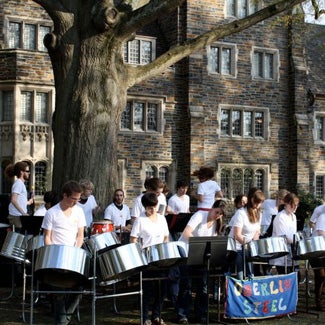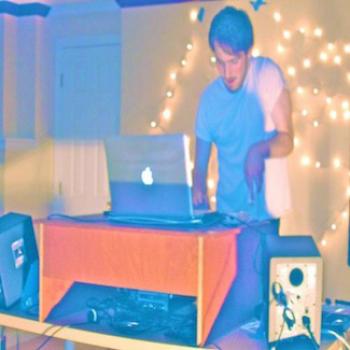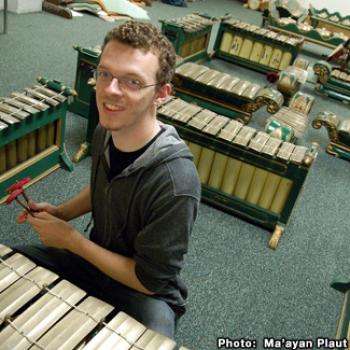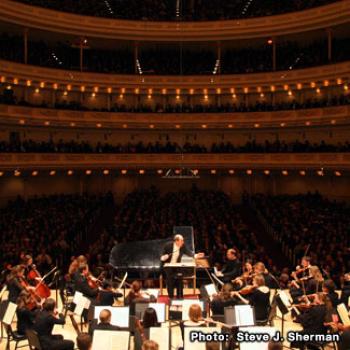On joining OSteel
Alicia Dudziak ’13
“I loved that I began to feel like a good musician even though my musical experience had been limited since age 10, when I quit piano.”

I first saw the Oberlin steel drum band during parent’s weekend of my first year at Oberlin. I had seen posters around campus advertising a steel drum band performing outside the Science Center, but hadn’t paid much attention. I went to the Science Center with my mom that day not expecting much, as I had never heard or seen a steel drum band play before. But as I was introducing my mom to my new friends and eating a bunch of free cheese, I got pretty into it. I didn’t know the music would be so danceable, so I was pleasantly surprised.
I saw the band, OSteel, for the second time at an event I helped organize, an abortion access fundraiser at the ’Sco called Work it for Women. OSteel played for a large group of dancing students in support of abortion access. As I watched with a friend of mine, I decided: I would become a member of OSteel.
I took the Steel Drum Exco in the spring of my first year and loved it. Dancing while playing the steel drums quickly became my favorite thing to do. I loved that I began to feel like a good musician even though my musical experience had been limited since age 10, when I quit piano. I loved the joy that the sound itself brought to the room and the energy of everyone in it. At the end of the semester, I applied for the band, hoping to get in. When I received the congratulatory e-mail, I told myself that I should think about it. But I knew that an Oberlin-life dream of mine was coming true, so I enthusiastically accepted.
At first, it was awkward. When I joined, the band was much smaller than usual because so many members had just graduated. I felt intimidated by older members and nervous that my inability to read music would get in the way of learning the multitude of complicated songs. But after a few rehearsals, I became super comfortable with the pans, the people, and our awesome dance moves.
Life as a band member has been quite a journey, as well as a defining component of my Oberlin experience. My social life shifted; hanging out with OSteel would often be the highlight of my week. I spent many of my weekend nights playing shows instead of attending them. I welcomed the chance to spend so much time with a group comprised of what I learned were many of my favorite people on campus. In short, I became pretty obsessed with OSteel.
After being in the band for a year, I wanted to involve myself even more, so I taught the Steel Drum ExCo during the fall of my junior year, in collaboration with two other band members. It quickly became the best part of my semester. My coteachers and I taught our students technique on pan and percussion, taught them four songs, facilitated group presentations, and supported their efforts to integrate dance moves into the final performance. Our students were enthusiastic about learning, playing, dancing, performing, and hanging out with each other. They even began their final performance with a skit about a lesbian zombie wedding.
One of my coteachers and I had frequent conversations about how to integrate the history of the steel drums into our class. We learned that the band had made attempts to do this in the past, but has not always succeeded in making steel drum history a priority. Three Oberlin students who had played pan before college founded OSteel in 1981. They played pan for winter term as a way to get other students interested. These founders heavily emphasized the history of the steel drums, and even brought the famous player and pan maker Ellie Mannette to campus to collaborate with them. Since then, the band has grown in size and popularity, but the acknowledgement of the history of the steel drums as an instrument, which were originally played by people of African and Caribbean descent in Trinidad and Tobago — and still are today — has not been a central focus of OSteel for a long time. These concerns evolved into conversations with the rest of the band about the accessibility of OSteel, the racial identity of the group, and how the band can more consciously integrate steel drum history into rehearsals, performances, and ExCo classes.
OSteel relates to other aspects of my life at Oberlin, be they musical, social, academic, or political. The most fulfilling aspect of the band has been that it enables me to combine so many different interests into one (incredibly enjoyable) experience.
Tags:
You may also like

On Oberlin’s inclusive music scene
“Collaboration plays a fundamental role in the community’s constant appetite for great art. This inclusivity is indicative of the communal Oberlin personality that makes it such an incredible place.”
Charles Abbott ’14

On learning to play the Gamelan
“...the difficulty helps me begin to lose my identity in the group and let me center myself. It’s become a way of life for me, and changed the way I view everything around me.”
Sean Hanson ’11

On playing Carnegie Hall
“I never truly understood the relationship between a conductor and an orchestra until I played under Robert Spano ’83.”
Hannah Levinson ’09